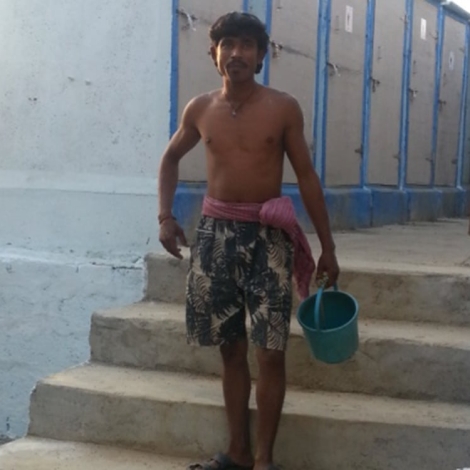
These biotoilets in a cluster process waste without need for disposal or additional infrastructure. Photo courtesy of Banka BioLoo
India’s sanitation problem needs a powerful, but low-cost solution. Half the country, or half of a billion people, lack regular access to toilets. Sewer infrastructure and centralized treatment are costly and point-of-source collectors like pit latrines require regular maintenance and emptying.
That’s why an Indian company called Banka BioLoo has turned to biotoilets. These systems incorporate military technology and extremophile bacteria to treat waste right at the toilet. The only byproducts are clean water, carbon dioxide and methane, and collecting the methane can yield combustible biogas for cooking or energy production.
“From the outside, a bio-toilet is similar to a normal toilet. The difference is primarily in terms of waste treatment,” Sanjay Banka, who leads the company with its founder, his wife Namita Banka, told E4C.
A clean culture
As Mr. Banka explains it, bio-toilets are easy to set up. They have a multi-chambered, matriced tank that holds a culture of bacteria that treats the waste. These bacteria are weather-resistant cryophiles with ancestors that hail from cold places like Siachen Glacier in the Himalayas and Antarctica. They have been adapted to work in a wide range of temperatures, eliminating waste in the oxygen-free, anaerobic bio-digester tank.

A biotank under a train car treats waste that otherwise may have gone onto the tracks. Photo courtesy of Banka BioLoo
The process destroys the microbes that cause disease and produces useful byproducts as it breaks down the waste. The water is safe for gardening and the bio-gas can be burned for heating, cooking and even electricity production.
“The system meets all regulatory and environmentally compliances and enhances the socio-environmental fabric of India,” Mr. Banka says.
The toilets might require a little user training, however. Too much flushing or use all at once can overload the tanks. And only human waste should be flushed, not paper, harsh chemicals or other materials. Those restrictions are one of the hidden costs of inexpensive waste treatment.
Going on the go
Travelers on Indian trains may have looked down into an onboard toilet and noticed the tracks visible below. Many trains still employ a system of moving open defecation, but Banka’s bio-toilets are helping to change that. Bio-digester tanks fitted under the car treat waste hygienically.
Related Resources
E4C Webinar | From technologies to lasting services in water, sanitation and hygiene technologies
Learn about two tools that evaluate the viability of WASH technologies.- Five questions with Jack Sim
The founder of the World Toilet Organization talks about the dirty subject that many people want to ignore. - From the Solutions Library
Closed Waterless Toilet Systems - Biogas Pit Latrine Waste Solution


THANKS FOR THE GREAT WORK AND CRITICAL THINKS
BUT HOWEVER I WOULD LIKE TO KNOW IN CASES WHERE SOME PEOPLE MY NOT BE A WERE OF THE SYSTEM AND THE USE TOILET PAPERS AND THE SYSTEM IS CLOGGED THE WITH WATER HOW DO U REMOVE THEM
THANKS AGAIN FOR THE INNOVATION
BEST REGARD
FROM SIMON